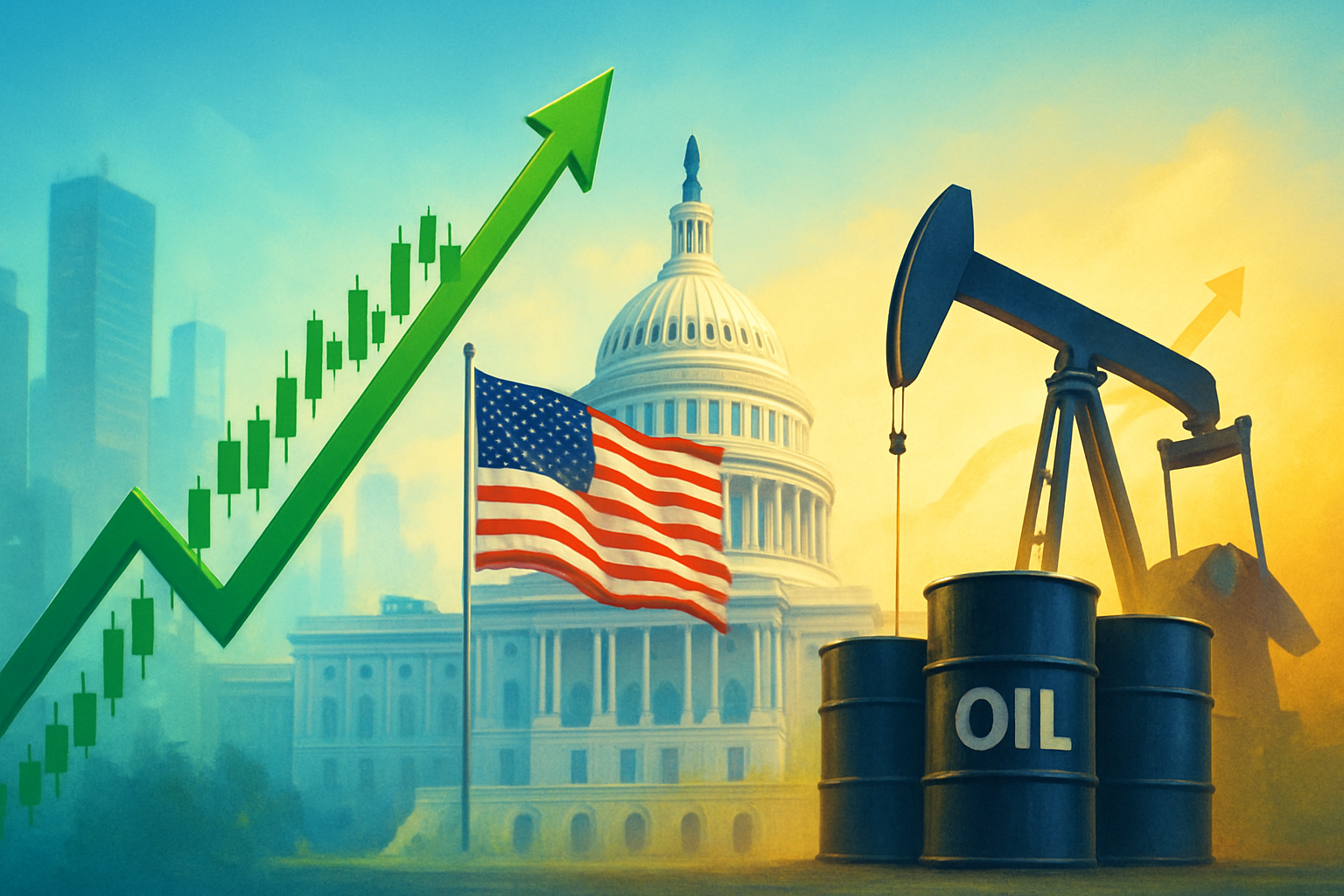
Washington D.C., November 10, 2025 – A wave of palpable relief swept through global financial markets today as fears of a prolonged U.S. government shutdown significantly eased, triggering a robust rally across all major indices. The prospect of an end to the record-long federal impasse, which had cast a long shadow over the economy for weeks, immediately translated into resurgent investor confidence and a notable uptick in crude oil prices.
The positive shift in sentiment signals a potential return to normalcy for the world's largest economy, with analysts pointing to a broad-based "relief rally." This immediate market response underscores the profound impact of political stability on economic outlooks and commodity markets, particularly in the energy sector, which had been grappling with demand uncertainties during the shutdown period.
The Brink Recedes: A Detailed Look at the Shutdown Resolution
The recent surge in market optimism stems from significant progress made towards resolving the U.S. government shutdown, which began on October 1, 2025, and spanned an unprecedented 41 days. This protracted standoff brought federal operations to a crawl, halting critical economic data releases and significantly eroding consumer and business confidence. The breakthrough came on Sunday, November 9, 2025, when a bipartisan deal advanced through a crucial procedural vote in the Senate, signaling a strong likelihood of its eventual passage.
The timeline of events leading to this moment has been fraught with tension. For weeks, negotiations between the White House and Congressional leaders had stalled over budget appropriations, with disagreements primarily centered on spending levels and specific policy riders. The shutdown's impact grew progressively severe, leading to furloughs for hundreds of thousands of federal workers, disruptions in various government services, and a palpable sense of economic uncertainty. Key players involved included the President, leaders from both the Democratic and Republican parties in the House and Senate, and various advocacy groups pushing for a resolution.
Initial market reactions to the news of the impending resolution were overwhelmingly positive. On Monday, November 10, 2025, the Dow Jones Industrial Average (DJIA) (NYSE: ^DJI) surged by over 650 points, marking an increase of approximately 1.8% and pushing past the 38,000 threshold. The broader S&P 500 Index (NYSE: ^GSPC) gained around 2.1%, while the technology-heavy Nasdaq Composite (NASDAQ: ^IXIC) led the charge with an impressive 2.5% climb. This widespread rally was further underscored by a sharp decline in the CBOE Volatility Index (VIX), often dubbed the "fear gauge," which dropped by more than 15%, reflecting a significant reduction in market anxiety. Global markets mirrored this sentiment, with Asian and European indices also posting substantial gains.
Companies Poised for Gains and Losses Amidst Renewed Stability
The easing of government shutdown fears is set to create a distinct landscape of winners and losers across various sectors, with the energy market, in particular, experiencing an immediate positive shock. Oil companies, which had been facing headwinds from demand uncertainty during the shutdown, are now poised for a significant uplift. Integrated oil majors such as ExxonMobil (NYSE: XOM) and Chevron (NYSE: CVX) are expected to benefit from strengthened demand forecasts and rising crude prices. Exploration and production (E&P) companies, including Occidental Petroleum (NYSE: OXY) and Pioneer Natural Resources (NYSE: PXD), could see increased profitability as their primary product commands higher prices. Service providers to the oil and gas industry, like Schlumberger (NYSE: SLB) and Halliburton (NYSE: HAL), are also likely to experience a rebound as drilling and production activities potentially ramp up.
Beyond the energy sector, the broader economic stability brought by the shutdown resolution is a boon for consumer discretionary companies. With consumer confidence expected to rebound from its three-year low, retailers like Amazon (NASDAQ: AMZN) and Walmart (NYSE: WMT), as well as travel and leisure companies such as Marriott International (NASDAQ: MAR) and Delta Air Lines (NYSE: DAL), could see increased spending. Financial institutions, including JPMorgan Chase (NYSE: JPM) and Bank of America (NYSE: BAC), stand to gain from reduced market volatility and a clearer economic outlook, which can stimulate lending and investment activities. Companies heavily reliant on government contracts, which faced delays and uncertainties during the shutdown, such as defense contractors Lockheed Martin (NYSE: LMT) and Raytheon Technologies (NYSE: RTX), are also set to resume normal operations and contract fulfillment, potentially recouping lost ground.
Conversely, while the overall market sentiment is positive, companies that thrived on the increased volatility or defensive plays during the shutdown might see a slight rebalancing. Certain gold mining companies, like Barrick Gold (NYSE: GOLD), which often benefit from safe-haven demand during periods of uncertainty, might experience a moderate cooling of investor interest as risk appetite returns. However, the overwhelming sentiment suggests that the benefits of renewed economic stability will far outweigh any localized adjustments. The restoration of federal economic data releases will also provide crucial clarity for all businesses, enabling more informed strategic planning and investment decisions, thereby reducing operational uncertainties that had plagued many sectors.
Wider Significance: A Return to Fundamentals and Global Ripples
The resolution of the U.S. government shutdown carries a wider significance that extends far beyond immediate market reactions, signaling a crucial return to economic fundamentals. For weeks, market participants had been forced to contend with political brinkmanship rather than core economic indicators. The end of the shutdown means that the focus can now shift back to inflation trends, employment data, and the Federal Reserve's monetary policy decisions, providing much-needed clarity for investment strategies. This event underscores the fragility of market stability when faced with political paralysis, setting a precedent for how future political impasses might be perceived and priced in by investors.
The ripple effects of this resolution are expected to be felt globally. The U.S. economy, as the world's largest, plays a pivotal role in global trade and financial flows. A stable U.S. economy translates into stronger global demand, benefiting export-oriented nations and companies. Competitors and partners across various industries, from technology to manufacturing, will likely see an improved operating environment as supply chains stabilize and consumer confidence in a major market is restored. For instance, European and Asian automotive manufacturers, which export heavily to the U.S., could anticipate a boost in sales. Furthermore, the return of reliable U.S. economic data will enable international organizations and central banks to make more accurate global economic forecasts, aiding in coordinated policy responses.
Regulatory and policy implications are also substantial. The prolonged shutdown highlighted vulnerabilities in government functions, potentially prompting discussions on mechanisms to prevent future impasses or to mitigate their economic impact. While specific policy changes are not immediately apparent, the experience could influence future budget negotiation tactics and emergency funding protocols. Historically, government shutdowns, while disruptive, have often been followed by periods of market recovery once a resolution is reached, as seen in previous instances in 2013 and 2018-2019. This current episode, however, was notable for its length, making the relief rally particularly pronounced and reinforcing the market's strong preference for predictability and stability over political uncertainty.
What Comes Next: Navigating the Path Ahead
With the immediate crisis averted, the focus now shifts to the short-term and long-term implications of this resolution. In the short term, markets are likely to continue their relief rally, albeit potentially at a more moderate pace, as investors fully price in the removal of the shutdown overhang. The resumption of federal operations will lead to a flood of delayed economic data releases, including crucial employment figures, inflation reports, and GDP estimates. These data points will be closely scrutinized for insights into the true health of the economy post-shutdown and will heavily influence the Federal Reserve's (FED) (NYSE: FED) upcoming monetary policy decisions. Businesses that faced operational disruptions or payment delays due to the shutdown will now work to normalize their activities and recoup lost revenue.
Looking further ahead, the long-term possibilities involve a renewed emphasis on fiscal responsibility and potentially more cautious approaches to future budget negotiations. While the immediate crisis is over, the underlying political divisions that led to the shutdown may persist, suggesting that similar impasses, though hopefully less severe, could re-emerge in the future. This event could prompt strategic pivots for companies to build greater resilience against political risks, perhaps by diversifying supply chains or markets. Market opportunities will likely emerge in sectors that benefit from renewed capital expenditure and consumer spending, particularly infrastructure, technology, and discretionary retail.
Potential challenges include the lingering effects of delayed investments and consumer confidence dips experienced during the shutdown. While sentiment has improved, fully reversing the negative impacts on certain small businesses or individuals may take time. Investors should also watch for any potential legislative fallout or attempts to address the root causes of such political gridlock. Scenarios range from a sustained period of economic growth bolstered by stability, to a more cautious recovery if underlying economic weaknesses are revealed by the delayed data. The key will be how quickly the government can fully restore its functions and how effectively businesses and consumers can regain momentum.
Comprehensive Wrap-Up: Stability Restored, Vigilance Remains
The resolution of the U.S. government shutdown represents a critical turning point for financial markets, effectively lifting a significant cloud of uncertainty that had suppressed investor sentiment for weeks. The immediate and robust market rally, particularly the uplift in oil prices, serves as a powerful testament to the market's strong preference for stability and predictability. Key takeaways include the profound impact of political events on economic performance, the resilience of markets to rebound once clarity emerges, and the critical role of government data in guiding investment decisions.
Moving forward, the market is poised for a period of adjustment as it assimilates the delayed economic data and assesses the true underlying strength of the U.S. economy. While the immediate crisis is over, investors should remain vigilant. The underlying political dynamics that led to the shutdown have not entirely vanished, suggesting that future legislative battles could still introduce volatility. The focus will now shift to corporate earnings, inflation trends, and the Federal Reserve's stance on interest rates, all of which will play crucial roles in shaping market direction.
In the coming months, investors should closely watch for the release of comprehensive economic indicators, particularly those related to employment and consumer spending, to gauge the pace of recovery. They should also monitor corporate guidance for insights into how businesses are adapting post-shutdown. The energy sector, in particular, will be a bellwether, with oil prices reflecting both renewed demand and global supply dynamics. This event underscores the cyclical nature of market sentiment and the enduring importance of political stability as a foundational element for economic prosperity.
This content is intended for informational purposes only and is not financial advice



